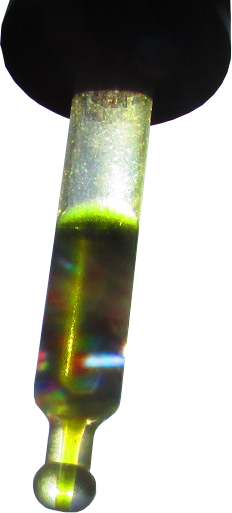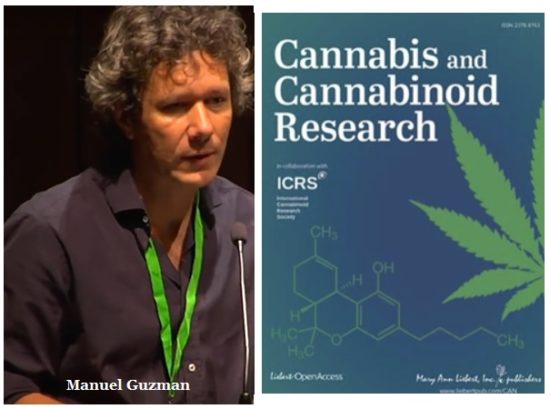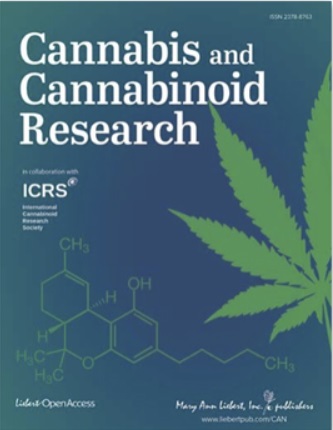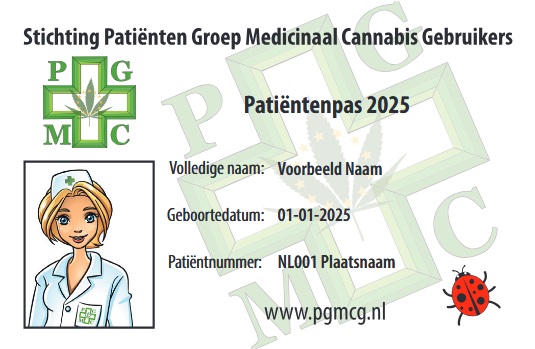Manuel Guzman: Cannabis voor het beheren van kanker symptomen. THC versie 2.0?
Onderstaand artikel is begin mei uitgebracht door Guzman Manuel, hij schrijft hoe cannabis kan helpen bij de symptomen bij kanker.
Het landschap van medicinale cannabis groeit snel. Cannabispreparaten worden al voor duizenden jaren in de geneeskunde gebruikt en nu is er een sterke renaissance in de studie van haar therapeutische eigenschappen. De overgrote meerderheid van de gecontroleerde klinische proeven die ondersteuning bieden voor het medisch gebruik van wat algemeen bekend is als “cannabis” of “marihuana” zijn daadwerkelijk uitgevoerd met zuivere cannabinoïden of een enkel extract van Cannabis sativa, waarin een equimolecular percentage van Δ9-THC en CBD. Op basis van deze studies, zijn THC/dronabinol (Marinol) en de synthetische analoge nabilone (Cesamet), evenals de nabiximols (Sativex), al goedgekeurd door verschillende regelgevende agentschappen, met inbegrip van Health Canada, FDA en EMA, als anti-emetic (misselijkheid en braken), anti-cachexic (gewichtsverlies en verlies spiermassa), pijnstiller of anti-spastisch geneesmiddelen.
Ruwe cannabispreparaten blijven echter veruit de meest voorkomende bron van cannabinoïden voor patiënten wereldwijd. Medicinale cannabis dispensatie programma’s zijn reeds geïmplementeerd in meer dan de helft van de Staten in de Verenigde Staten, alsook in een groeiend aantal landen wereldwijd. Hoewel dit “levend laboratorium” voor gebruikers van medicinale cannabis inderdaad het potentieel heeft van het verstrekken van een schat van observationele gegevens, hebben helaas zeer weinig studies de therapeutische waarde van bijvoorbeeld cannabis olie of verdampte cannabisbladeren onderzocht. In feite, is in principe niets bekend over de demografische en pathologische kenmerken van patiënten met behulp van cannabis, de patronen van het gebruik van verschillende cannabissoorten, de profielen van de werkzaamheid en veiligheid van die cannabispreparaten, en hun meest geschikte doses en wijzen van toediening.
Israël, onder leiding van Prof. Raphael Mechoulam, is een van de meest vooraanstaande landen in wetenschappelijk en klinisch cannabisonderzoek wereldwijd. Op deze gronden en sinds 2007, verstrekt het Israëlische ministerie van volksgezondheid vergunningen voor medicinaal cannabisgebruik. Tegenwoordig zijn er > 30.000 patiënten in Israël die cannabis nemen, met name voor de palliatie van kanker symptomen. In de maart 2018 uitgave van de European Journal of Internal Medicine, Bar-Lev Schleider et al. geeft een waardevol epidemiologische inzicht ∼3000 van die kankerpatiënten hadden cannabis voorgeschreven gekregen voor het beheer van hun maligniteit-geassocieerde symptomen.1 dit cohort, hoewel enigszins heterogeen, kon over het algemeen beschouwd worden als “ernstig ziek.” Bijvoorbeeld, op de basislijn lijden ongeveer de helft van de patiënten onder fase 4 kanker; ongeveer de helft van de patiënten hun pijn rapporteerde als intense (8 over 10); de gemiddelde leeftijd van de patiënten was relatief gevorderd (∼60-jarige); en het aantal symptomen wat gemeld is per patiënt was zeer hoog (gemiddeld 11, met inbegrip van slaapproblemen, pijn, angst en depressie, zwakte en vermoeidheid, misselijkheid en braken, en verlies van eetlust). Na 6 maanden van follow-up, was 24,9% van de patiënten gestorven en 18,8% was gestopt met de behandeling. Van de resterende, 60,6% reageerde op de vragenlijst. Met betrekking tot de algehele werkzaamheid werd door 95,9% van de patiënten melding gemaakt van een (belangrijke of matige) verbetering van hun toestand. Ook alleen 18,8% van de patiënten rapporteerde een goed/zeer goede kwaliteit van leven vóór aanvang van de behandeling, terwijl 69,5% dit deed na het regime van de 6-maand cannabis inname. Met betrekking tot de algehele veiligheid, werd cannabis over het algemeen goed verdragen en de meeste bijwerkingen die zijn gemeld zijn, zoals slaperigheid, duizeligheid en droge mond, wat kan worden beschouwd als mild, met name in het kader van een geavanceerde kanker patiënten populatie.
Deze studie geeft een kostbaar stukje informatie over het gebruik van medicinale cannabis voor het beheren van kanker symptomen. De steekproef bevolking was groot, en een prospectieve follow-up met vrij hoge waarde voor betrokkenheid en reacties werden bereikt. Echter, zo inherent ze zijn aan de meeste observationele studies, is de studie ook gebonden aan herkenbare beperkingen zoals het ontbreken van een placebogroep, de patiënt zelfselectie bias, het gebrek aan controle over andere bijkomende behandelingen (bv chemotherapie), en het gebruik van subjectieve vragenlijsten in plaats van objectieve parameters voor de beoordeling van de gezondheidstoestand van de patiënt.
—–
Perhaps the observation of the study that has been most actively stressed by the mass media (see, e.g., https://www.rollingstone.com/culture/news/new-study-suggests-pot-could-help-end-opioid-dependency-w517178) is the observed drop in opioid use: although opioids were the most consumed drug by patients at enrollment, after 6 months of cannabis use, 36.0% of them had stopped taking opioids entirely, and an additional 9.9% decreased their dosage. In the face of the dramatic opioid epidemic in the United States, this finding offers reasons for hope. However, in my opinion, this potential inverse relationship between cannabis and opioid use in the clinical setting deserves at least a cautionary comment. For example, data from Medicare Part D enrollees from 2010 to 2013 revealed that prescriptions for pain medication, including opioids for pain, fell in states with medical cannabis laws, resulting in savings of US$165.2 million in 2013 alone.2 Similarly, a 2015 RAND Bing Center for Health Economics study found that states permitting medical cannabis dispensaries experienced a relative decrease in opioid addictions and opioid overdose deaths.3 Another recent report, by collecting survey data from medical cannabis patients, also suggested that cannabis contributes to reducing opioid-based pain medication.4 Clinical research into the interactions between cannabis and opioids in pain patients is limited, but pilot studies indicate that medical cannabis intake tends to reduce the dose of opioids required for pain relief.5,6 The website of the National Institute on Drug Abuse, one of the National Institutes of Health (https://www.drugabuse.gov/publications/marijuana/marijuana-safe-effective-medicine), upon reviewing of this current evidence, notes that “Though none of these studies are definitive, they cumulatively suggest that medical marijuana products may have a role in reducing the use of opioids needed to control pain.”
The notion that opioid use decreases upon concomitant cannabinoid use is actually challenging, and stands supported by some pre-clinical and “real-patient” data, but, unfortunately, it is not sustained yet by rigorously controlled clinical studies. We cannot forget that association is not causality, and that the plural of anecdote is not evidence. Identifying effective pain-management strategies alternative to opioid analgesics is a clear public health priority. As Bar-Lev Schleider et al. discuss in their article, most patients using medical cannabis report that it has fewer and less severe side effects than their concurrent prescription drugs, especially opioids. Hence, well-designed, large controlled trials are urgently warranted to determine whether combining cannabinoids with opioids can actually reduce the amount of opioids necessary to manage pain.
C. sativa is a plant with a complex and varied chemical composition,7 so it is essential to define its precise chemotypes to offer one of them to a specific patient as a valid therapeutic option. Considering the hundreds of compounds that are present in cannabis (cannabinoids, terpenes, polyphenols, steroids, flavonoids, etc.), it is clear that a substantial part of them can, at least theoretically, exert biodynamic actions on the human body. In the study by Bar-Lev Schleider et al., each patient was prescribed at least one out of 18 different cannabis strains. Most patients used THC-rich, CBD-poor, indica-like strains, which were usually complemented with various sativa-like and/or CBD-rich strains. Moreover, almost half of the patients combined the use of oils and inflorescences (including flowers, capsules, and cigarettes). Unfortunately, the study had not sufficient statistical robustness to substratify the patients for this complex array of cannabis preparations.
In any case, based on our current knowledge on the mechanism of cannabinoid action, it is most conceivable that the therapeutic activity of these THC-rich preparations for treating classical cancer symptoms is due to the THC-induced activation of cannabinoid CB1 receptors located on precise anatomical sites.8,9 This includes, for example, inhibition of nausea and vomiting, stimulation of appetite, attenuation of cachexia/energy expenditure, and reduction of pain, in which effects mediated by cannabinoid CB2 receptors could also be involved. Likewise, engagement of cannabinoid CB1 receptors located on specific brain areas most likely underlies the typical side effects described in the commented study, such as dizziness, somnolence, confusion, and disorientation.
Beyond THC, it is becoming increasingly accepted that CBD, aside from exerting its own therapeutic activity, buffers the psychoactive risk of cannabis.10 Thus, THC/CBD-balanced preparations, obviously if well produced and standardized, could be considered a therapeutically safer option than dronabinol or nabilone, whose therapeutic windows are usually very narrow. Other constituents of cannabis, especially terpenes (e.g., myrcene, α-pinene, and β-caryophyllene), have been proposed to exert synergic therapeutic actions with phytocannabinoids.11 However, scientific proof for this potential “entourage effect” is still missing.
In sum, the one million dollar question of “what would be the best cannabis chemotype and, in particular, THC/CBD ratio for each particular patient in each particular pathological status?” remains a pending question in the field. It seems really far from our logistic, economic, and human resources (especially under the current restrictive frameworks that regulate clinical research with substances considered to be narcotic drugs) to conceive clinical trials with tens of thousands of patients to compare different pure cannabinoids, either alone or in combination, with other cannabinoids and terpenes, versus different cannabis extracts, all of them administered by different routes and for different diseases. Therefore, more realistically, a multifactorial approach to the problem could be considered from three complementary levels: (1) Pre-clinical studies aimed at evaluating interactions between different (cannabinoid and noncannabinoid) compounds from a biochemical, pharmacological, and behavioral perspective could suggest candidate combinations to be used in therapy. (2) Controlled clinical trials with the most appropriate selection of such combinations of compounds could provide accurate data on efficacy and safety (e.g., dosage and treatment durations, and pharmacokinetic parameters). (3) Observational studies with different chemotypes, preparations, and delivery procedures, mainly under the umbrella of medicinal cannabis dispensation programs, could provide signs of whether, for example, cannabis oils or herbal cannabis are more effective and/or better tolerated than THC and CBD (alone or combined in different proportions).
Compared with pure cannabinoids, medical-grade cannabis preparations may offer, in theory, the possibility to personalize—and therefore improve—therapeutic interventions in terms of different THC/CBD ratios, activating (sativa-like) versus sedating (indica-like) cannabis strains, and slow (e.g., oral oils) versus fast (e.g., vaporized inflorescences) routes of delivery. However, as already mentioned, additional rigorous clinical studies are warranted for us to move from scattered anecdotal evidence to clinical knowledge. Nowadays, on practical grounds, interpretation of empirical records on medical cannabis use, combined with a rational application of our current understanding of the mechanism of cannabinoid action, as well as some “trial and error,” may be the only way to delineate which cannabis preparations may adjust best (in terms of efficacy and tolerability) to the specific needs of each patient at each disease stage. Hopefully, this relatively fragile strategy will evolve in the near future for the appreciable benefit of the patient.
(We zijn momenteel nog bezig met de vertaling, excuses voor het ongemak)




